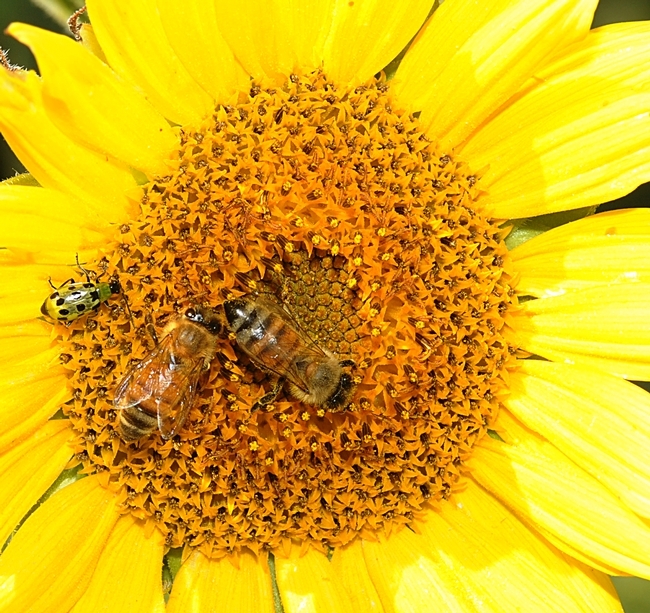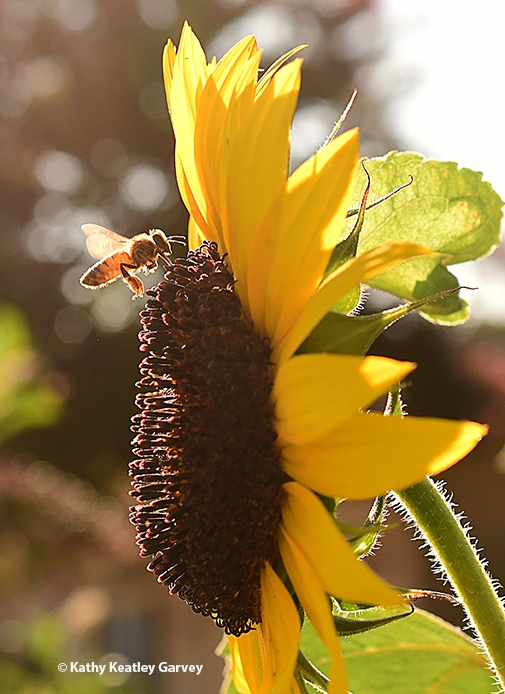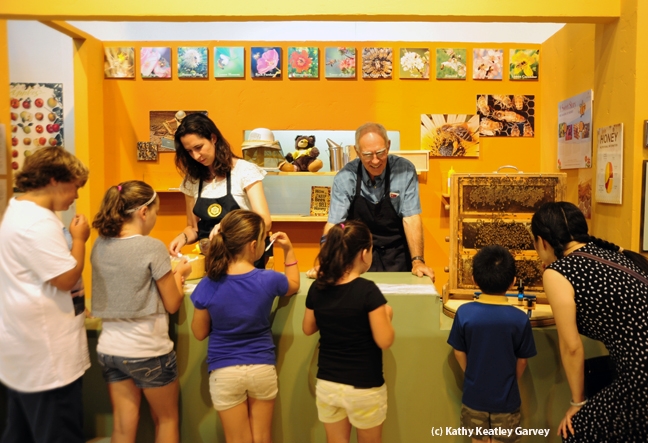- Author: Kathy Keatley Garvey

An 11-member team of researchers led by UC Davis scientists reveals insight on "how and why" in a newly published article in the journal New Phytologist.
The title, "Flower Orientation Influences Floral Temperature, Pollinator Visits and Plant Fitness," tells part of the research, headed by senior author Stacey Harmer, professor of plant biology, College of Biological Sciences.
"Sunflowers face the rising sun because increased morning warmth attracts more bees and also helps the plants reproduce more efficiently, according to a study by researchers at the University of California, Davis," wrote UC Davis science writer and public information representative Andy Fell in a news release.
"While sunflowers are growing, their heads turn back and forth to track the sun during the day," Fell related. "Previous work from Harmer's lab showed that this tracking is controlled by the plant's internal circadian clock."
Some excerpts from the UC Davis news story:
"...as the flower heads, or capitula, mature and their stems become stiff and woody, this movement decreases until the heads are all facing the morning sun. When postdoctoral researcher Nicky Creux changed the orientation of sunflowers by turning their pots around, she (Harmer) noticed that east-facing flower heads attracted a lot more bees, especially in the morning, than plants facing west."
"The orientation of the plants also affected flower development and reproductive success. East-facing plants tended to produce larger and heavier seeds. They also released pollen earlier in the morning, coinciding with the times when bees visit."
The team included scientists from the Harmer lab, as well as researchers from the University of Virginia and UC Berkeley.
The researchers summarized their work--funded by the National Science Foundation and the U.S. Department of Agriculture's National Institute of Food and Agriculture (USDA-NIFA)--with these four key points:
- Effective insect pollination requires appropriate responses to internal and external environmental cues in both the plant and the pollinator. Helianthus annuus, a highly outcrossing species, is marked for its uniform eastward orientation of mature pseudanthia, or capitula. Here we investigate how this orientation affects floral microclimate and the consequent effects on plant and pollinator interactions and reproductive fitness.
- We artificially manipulated sunflower capitulum orientation and temperature in both field and controlled conditions and assessed flower physiology, pollinator visits, seed traits and siring success.
- East-facing capitula were found to have earlier style elongation, pollen presentation and pollinator visits compared with capitula manipulated to face west. East-facing capitula also sired more offspring than west-facing capitula and under some conditions produced heavier and better-filled seeds. Local ambient temperature change on the capitulum was found to be a key factor regulating the timing of style elongation, pollen emergence and pollinator visits.
- These results indicate that eastward capitulum orientation helps to control daily rhythms in floral temperature, with direct consequences on the timing of style elongation and pollen emergence, pollinator visitation, and plant fitness.
You can read the entire paper here.
Harmer and Creux created a video that illustrates the research, basically "that bees prefer to visit east-facing sunflowers than sunflowers that have been turned to face west. East-facing sunflowers are warmer and release pollen earlier to coincide with bee visits." Access the YouTube video below.

- Author: Kathy Keatley Garvey
By day, they fly around our yard looking for the girls.
At night, it's "Boys' Night Out."
These males, longhorned digger bees, Melissodes agilis (as identified by native pollinator specialist Robbin Thorp, emeritus professor of entomology at UC Davis), are absolutely spectacular. At night the males roost on our lavender stems, sometimes 8 to 10 on a single stem. Their "bedroom" gets quite crowded.
Melissodes are ground-nesting solitary bees. While the males sleep overnight on the flowers, each female is tucked away in her ground nest.
According to the Discoverlife.org: "With the apparent exception of Florida, agilis occurs throughout the United States, Southern Canada and Northern Mexico, and is in flight from May to November in the East."
Christopher O'Toole and Anthony Raw write in their book, Insects of the World, that Melissodes are found on all continents except for Australia. "The males of nearly all species have very long antennae and are colloquially known as 'longhorned bees.'"
These bees frequent plants of the sunflower family, Helianthus. In our yard, they gravitate toward the blanket flowers (Gallardia) and Mexican sunflower (Tithonia).
We've found them "going to bed" at 6 p.m. and rising around 7 a.m. We clocked one "sleepy head" getting up at 10:30 a.m. as honey bees and bumble bees buzzed around him, foraging for nectar on the lavender.
That was on Sunday, Father's Day.



- Author: Kathy Keatley Garvey
Bees, butterflies and sunflowers at the California State Fair?
Yes.
The state fair, which opened July 12 and ends July 28, is a good place to see a bee observation hive, honey bees on sunflowers, carpenter bees on petunias, and butterflies in the Insect Pavilion, aka Bug Barn.
If the purpose of a fair is to educate, inform and entertain, then that's what this fair does. A recent stop at the 160th annual fair provided a glimpse of what's going on in the entomological world--and what shouldn't be going on in the petunia patch.
At the California Foodstyles in the Expo Center, beekeeper Doug Houck of the Sacramento Area Beekeepers' Association and his daughter, Rebekah Hough, urged folks to find the queen bee, worker bees and drones in the bee observation hive. Then the fairgoers sampled the honey.
Sweet!
At the Bug Barn, mounted butterflies drew "oohs" and "ahs." Just a few of the butterflies: Monarchs, Western Tiger Swallowtails, Great Purple Hairstreaks, Dusty-Winged Skippers, Red Admirals, and Painted Ladies. The Bohart Museum of Entomology at UC Davis, home of nearly eight million specimens, provided some of the butterflies.
Cool!
Outside the Insect Pavilion, a garden thrived with tall-as-an-elephant's-eye sunflowers. Honey bees and sunflower bees buzzed among the heads--sunflower heads and fairgoers' heads.
Beautiful!
The most disconcerting scene: teenagers screaming when they heard and saw the female Valley carpenter bees nectaring petunias. "Ick, big black bees!" said one as she quickly ran off.
"Carpenter bees," a middle-aged bystander commented dryly as she sauntered off to see the sturgeon display.
Another teenager approached the petunia patch, and she, too, bolted. "They're going to sting me!" she yelled.
It's rather sad that the first reaction on seeing bees in a flower bed is not "pollinator" or "pretty flowers" or "pink petunias" but "sting."
When did "Big Fun" become "Big Scare?"




- Author: Kathy Keatley Garvey
You can tell it's summer along Yolo County roads by the acres and acres of sunflower fields.
Looking like real-life Van Gogh paintings (Van Gogh painted them in vases, Mother Nature paints them in rows), the sunflower fields are nothing short of spectacular. With tousled heads rising toward the sun and golden locks nodding in the breeze, they stand their ground.
Sunflowers (Helianthus Annuus), native to North America, are one of our most recognizable flowers. They're a good food source, a designer's dream, and dugout tradition.
Earlier this year we fielded a call from a young man from southern California who wanted to know when the sunflowers would bloom in Yolo County. He wanted to propose to his girlfriend in a sunflower field.
This is one agricultural crop that does not go unnoticed. Not by people, not by animals, not by birds, and especially not by honey bees and sunflower bees.



- Author: Kathy Keatley Garvey
Sunflowers, native to the Americas, are spectacular, especially when you encounter a field of them. If you look closely, you'll see honey bees, sunflower bees and bumble bees working the flowers.
It's pollination at work.
To encourage backyard gardeners to grow sunflowers and collect data about the bees that visit them, the Great Sunflower Project provides free seeds and educational information.
You can obtain the Lemon Queen sunflower seeds from the Great Sunflower Project, from a local nursery or from a seed catalog.
Associate professor and biologist Gretchen LeBuhn of the University of California, Santa Barbara, started the project in 2008 as a way to get citizens interested in bee pollination.
"In 2008, we started this project as a way to gather information about our urban, suburban and rural bee populations," writes LeBuhn, considered "the queen bee" of the Great Sunflower Project. "We wanted to enlist people all over the U.S. and Canada to observe their bees and be citizen scientists. We asked them to plant sunflowers in their gardens so we could standardize study of bee activity and provide more resources for bees. Sunflowers are relatively easy to grow and are wildly attactive to bees."
Since 2008, the Great Sunflower Project has expanded its list of plants studied to include bee balm, cosmos, rosemary, coreopsis (tickseed), and purple coneflower.
"It’s time to turn off your television, take off those earphones, shut down that computer, go outside, and rediscover the wonder of nature," LeBuhn says.
Good advice.
That's one small step toward improving bee habitat--and human habitat, too.





